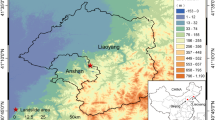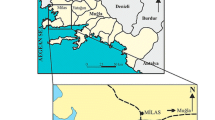Abstract
With the increasing adoption of the surface mining of coal, problems associated with spoil pile instability, which affects resource recovery, mining cost, and safety and presents environmental hazards, have become a matter of prime concern to mine planners and operators. The study of geotechnical aspects is thus very important in the rational planning for the disposal, reclamation, treatment and utilization of spoil material. A strip coal mine, one of the largest open pit mines in Turkey, is located in Central Anatolia and provides coal to a thermal power station. Coal production is carried out in two adjacent open pits, the Central Pit and South Pit. A large-scale spoil pile instability over an area of 0.3 km2 occurred within the dumping area of the Central pit. In addition, small-scale movement occurred in the outside dumping area. This paper outlines the results of field and laboratory investigations to describe the mechanisms of the spoil pile instabilities and to assess deformations monitored over a long period following the failure. Shear test results indicate that the interface between the floor and spoil material dumped by dragline has a negligible cohesion and is the most critical plane of weakness for spoil pile instability. Back analyses based on the method of limit equilibrium and the numerical modelling technique, and observations in the pit revealed that failure occurred along a combined sliding surface consisting of a circular surface through the spoil material itself and a planar surface passing along the interface between the spoil piles and floor. The analyses also indicated that pore water pressure ratios of about 0.25 satisfy limiting equilibrium condition and that rainfall about one month before the failure may be a contributing factor to the instability. Movement monitoring data obtained following the failure over a 1.5-year period suggested that the ongoing deformations were mainly due to compaction of the spoil material. Based on the monitoring data and the results of the analyses, the failure mode of the local instability occurring at the outside dumping area was considerably similar to that of the large instability.














Similar content being viewed by others
References
ASTM (American Society for Testing and Materials) (1994) Annual book of ASTM standards—oil and rock, building stones, Section 4, Construction. V.04.08, ASTM Publication
Barton NR, Kjarnesli B (1981) Shear strength of rockfill. ASCE J Geotech Eng Div 107:873–891
Bowman PM, Gilchrist HG (1978) Waste dump instability and its operational impact for a Canadian Plains lignite mine. In: Proceedings of the international symposium on stability in coal mining. Vancouver, British Colombia, Canada, pp 381–394
Janbu N (1973) Slope stability computation. Embankment dam engineering, Cassagrande volume. In: Hirschfield RC, Poulos SJ (eds) Wiley, NewYork, pp 47–86
MTA (1976) Feasibility report for a coal field in Central Anatolia. General Directorate of Mineral Research and Exploration of Turkey (unpublished report in Turkish)
Plaxis (1998) Finite element code for soil and rock analyses. Balkema, Netherlands
Okagbue CO (1987) Stability of waste spoils in an area strip mine - geological and geotechnical considerations. Earth Surf Processes Landforms 12:189–300
Richards BG (1982) The finite element analysis of mine spoil slopes using slip elements to simulate strain softening yield behavior. Civil Eng Trans 24(1):69–76
Richards BG, Coulthard MA, Toh CT (1981) Analysis of slope stability at Goonyella Mine. Can Geotech J 18:179–194
Slope 8 (1999) GeoStru Software version 8.0 revision 52 User’s Manual. GeoStruct Enterprise, Italy
Speck RC, Huang SL, Kroeger EB (1993) Large-scale slope movements and their affect on spoil-pile stability in Interior Alaska. Int J Surface Min Recl 7(4):161–166
Stead D, Singh R (1989) Loosewall stability in United Kingdom surface coal mines. Can Geotech J 26:235–245
Taylor RK (1973) Compositional and geotechnical characteristics of a 100-year-old colliery spoil heap. Trans Min Metall 82(784):A1–A14
Thompson MG, Rodin S (1972) Colliery spoil tips - after Aberfan. Inst Civil Eng 7522:60
Ulusay R, Arikan F, Yoleri MF, Çağlan D (1995) Engineering geological characterization of coal mine waste material and an evaluation in the context of back – analysis of spoil pile instabilities in a strip mine, SW Turkey. Eng Geol 40:77–101
Ulusay R, Çağlan D, Arikan F Yoleri MF (1996) Characteristics of biplanar wedge spoil pile instabilities and methods to improve stability. Can Geotech J 33(1):58–79
Williams DJ, Walker LK (1985) Laboratory and field strength of mine waste rock. Civil Eng Tran 27(3):299–304
Acknowledgements
The authors wish to acknowledge the cooperation and valuable support of the mining company and mine personnel. They would also like to thank Nihat Sinan Işık (Gazi University) for his valuable contributions in numerical analyses.
Author information
Authors and Affiliations
Corresponding author
Rights and permissions
About this article
Cite this article
Kasmer, O., Ulusay, R. & Gokceoglu, C. Spoil pile instabilities with reference to a strip coal mine in Turkey: mechanisms and assessment of deformations. Environ Geol 49, 570–585 (2006). https://doi.org/10.1007/s00254-005-0092-1
Received:
Accepted:
Published:
Issue Date:
DOI: https://doi.org/10.1007/s00254-005-0092-1




